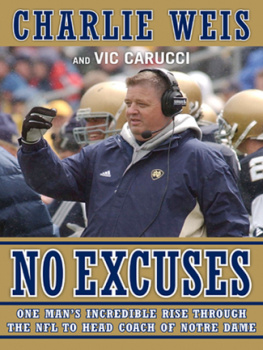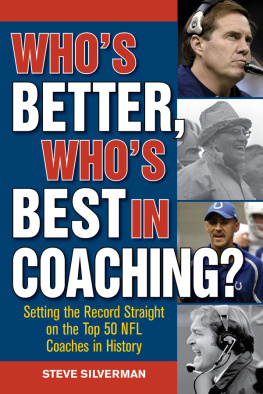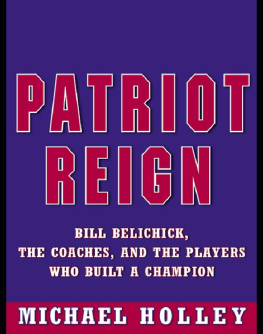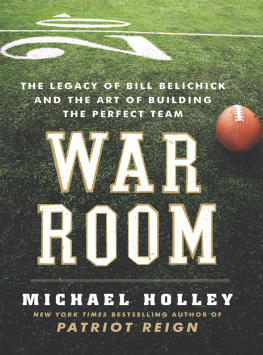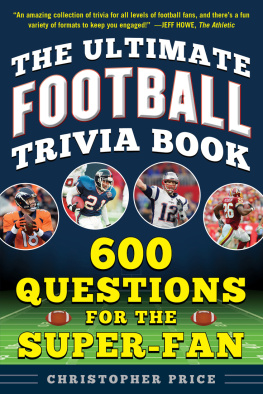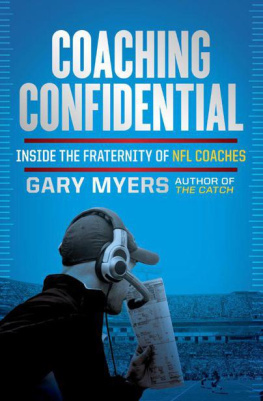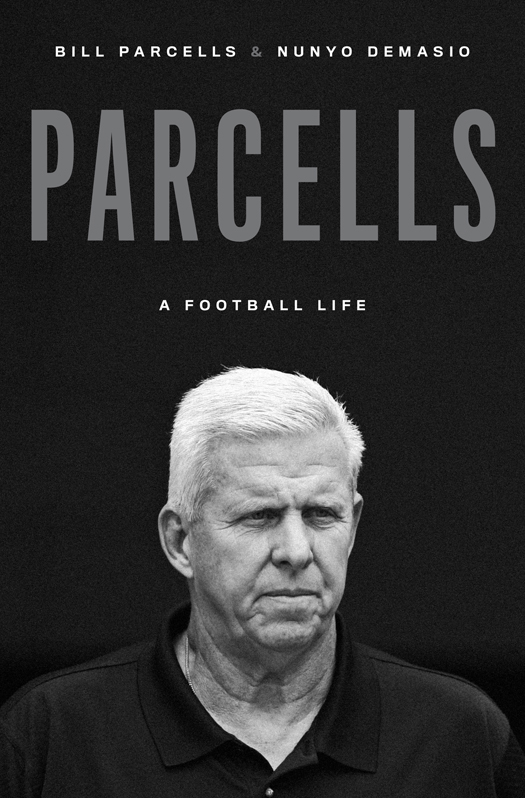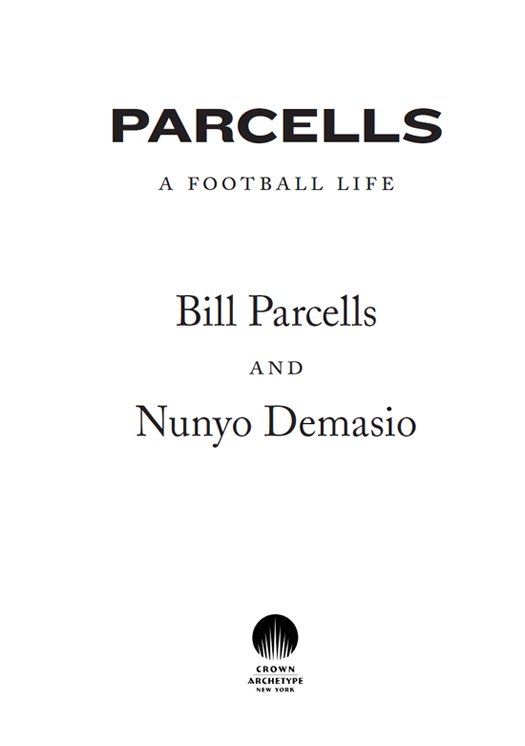Copyright 2014 by Bill Parcells and Nunyo Demasio
All rights reserved.
Published in the United States by Crown Archetype, an imprint of the Crown Publishing Group, a division of Random House LLC, a Penguin Random House Company, New York.
www.crownpublishing.com
Crown Archetype and colophon is a registered trademark of Random House LLC.
Library of Congress Cataloging-in-Publication Data
Parcells, Bill, 1941
Parcells : a football life / Bill Parcells, Nunyo Demasio.
pages cm
1. Parcells, Bill, 1941 2. Football coachesUnited StatesBiography. 3. New York Giants (Football team) I. Demasio, Nunyo. II. Title.
GV939.P35A3 2014
796.332092dc23
[B] 2014027830
ISBN 978-0-385-34635-1
eBook ISBN 978-0-385-34636-8
Jacket design: Christopher Brand
Jacket photograph: Getty Images
v3.1
T O M ICKEY C ORCORAN ,
a perfect role model for an aspiring young coach.
T O D ORCAS D EMASIO ,
a special woman who started calling her oldest son a writer several years before he officially became one.
Contents
PARCELLS
A FOOTBALL LIFE
T ucked between two volcanic areas in southwestern Italy, the coastal city of Naples at the turn of the twentieth century was among the poorest regions in Europe. Baldassare Naclerio was thirteen when his family moved from Naples to New York City in 1900, part of a tidal wave of Italian immigrants flooding the United States in search of economic opportunity. Like many others embracing assimilation, Baldassare Americanized his first name, becoming Harold.
The Naclerios lived in the upper Manhattan neighborhood of Harlem, which wouldnt become an African-American enclave for several more decades. Within months of his arrival, Harold used his woodworking skills to find employment as a cabinetmaker. Several years later he met Julie Ferrioli, another native of Naples. The two teenagers fell in love, married, and moved to tiny Wood-Ridge, New Jersey, to raise a family. Perched atop a hill, their house was weather-beaten yet cozy, with a small yard and garden that Harold kept immaculate.
Harold found a full-time job with the American Bell Telephone Company. He supplemented the family income with part-time employment as a mechanic and barber while applying woodworking and masonry skills on his home. By age nineteen, Julie Naclerio had a brood of three, which would grow to five and include an energetic, outspoken girl named Ida. After graduating from high school, Ida decided against attending college and landed a job at Lever Brothers, a Britain-based soap manufacturer with subsidiaries in several countries. Of Idas $5 weekly salary, she contributed $3 to her parents for expenses; like most women of her generation, her best hopes lay in marrying the right man.
O n August 10, 1913, Charles OShea was born to an Irish couple in Cambridge, Massachusetts. Within a few years the boys father died in his sleep and his mother succumbed to the influenza epidemic of 1918. One of the deadliest in history, the pandemic killed about 50 million people, wiping out one-fourth of Americas population. Orphaned at age five, Charles was adopted by his aunt Esther St. George. When she married a man whose surname was Parcells, her nephew also took the last name. After purchasing two rooming houses on a downtown block, the family moved to Hackensack, New Jersey. Lucinda Whiting, a black cook and maid at the establishment, helped raise Esthers quiet nephew, doting on him so much that he came to view her as a mother.
Charles grew up to be a six-foot-one, wiry teenager with blazing speed, ramrod posture, and an incongruous nickname: Chubby. During the late 1920s, Chubbys athleticism and passion led him to become a three-sport phenomenon at Hackensack High. Also academically inclined, Charles was pursued by several top colleges, and the 195-pounder accepted a football scholarship from Georgetown University, where he would also run track and play basketball. For most of his college football career Charles was coached by Jack Hagerty, who had once played for the New York Giants, helping them capture the 1927 NFL title.
At Georgetown, Hagerty discarded the Notre Dame Box, a single-wing offense that had flourished during the 1920s under Knute Rockne, the Fighting Irish legend, in which the running backs lined up in a box formation. Instead Hagerty installed the single-wing offense used by the Giants, based on a long snap and four backs: tailback, fullback, quarterback (blocking back), and wingback. The line was unbalanced: two players lined up on one side of the center and four on the other. The formation, which resembled a wing, emphasized chicanery more than power. Playing in this Giants-style offense, Charles Parcells became one of the top halfbacks in the East. He was also versatile enough to line up at quarterback and to make point-after kicks.
W hen Charles Parcells graduated in 1935 he entered Georgetowns law school, where he earned his Juris Doctor before taking a job as an agent for the Federal Bureau of Investigation. On returning to Hackensack he met Ida Naclerio in nearby Wood-Ridge. Idas diminutive size belied her forceful nature. Often heard before being seen, the boisterous Italian woman provided a dramatic counterpoint to the tall, reserved Irishman. Where Ida turned the smallest issues into melodrama, Charles was quick to shrug and smile. The soft-spoken G-man was smitten, and after an ardent courtship he persuaded Ida to marry him. The couple moved to Hackensack, where Ida loudly worried about her husbands safety as a law-enforcement officer. Those concerns were only heightened by the birth of their first child.
Duane Charles Parcells arrived at Englewood Hospital in New Jersey on August 22, 1941. Astrological signs for the newborn indicated that he would be ambitious, autocratic, caring, excitable, generous, proud, strong-willed, and destined for big things. From Napoleon to Barack Obama, Leos have tended to be natural leaders, energetic taskmasters to whom others gravitate for guidance; those born between August 15 and August 22 are considered particularly hotheaded and impatient. Fond of the spotlight, they turn sullen when upstaged. Complex and volatile, Leos can be egomaniacal one moment and grounded the next, cocksure yet thin-skinned; despite being detailed-oriented, they are better at organizing the lives of others than their own.
D uane Bill Parcellss earliest memory places him in the backseat of the family car on the Pennsylvania Turnpike. His younger brother Don is crying as their father barrels through the turnpikes dark tunnels, but three-year-old Duane feels only excitement. Their fathers FBI job has taken the family to Des Moines, Iowa, then Joliet, Illinois, which means occasional road trips east, like this one, to see relatives. In time, Charles will capitulate to Idas badgering and return to New Jersey, taking a job at the United States Rubber Company as director of industrial relations, commuting to the companys office in midtown Manhattan.
Charles and Ida decided to settle in suburban Hasbrouck Heights, slightly north of Wood-Ridge and south of Hackensack. Charles paid $8,000 for a gray-and-white, single-story house on Columbus Avenue, where he converted the attic into a bedroom for Duane and Don. Only a few blocks away in the quiet, tree-lined neighborhood, Frank Sinatra lived with his wife, Nancy, and their newborn girl. Singing for the Tommy Dorsey Orchestra, the Hoboken native had established himself as one of Americas most popular vocalists. The white exterior of Sinatras seven-room clapboard home was often smeared with red-lipsticked messages from infatuated girls. On sunny days Sinatra and his wife walked their baby stroller past Charles Parcellss new home.


